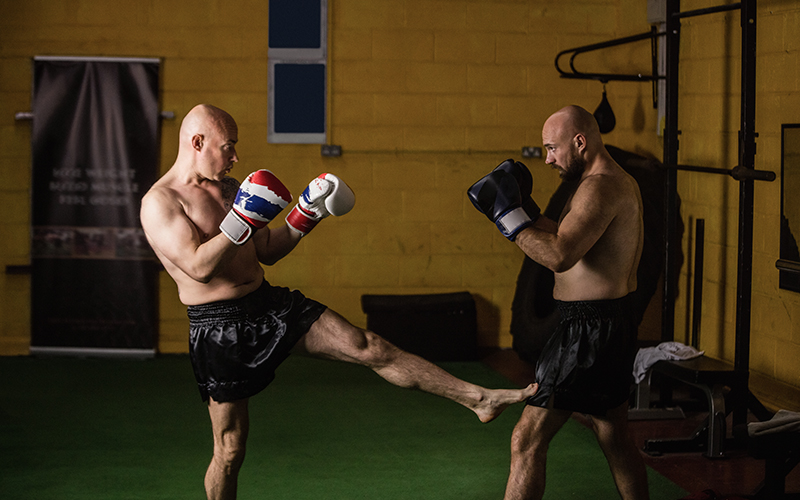Introduction to Kickboxing
What is Kickboxing?
Kickboxing is more than a high-energy combat sport. It’s a harmonious blend of punches, kicks, and defensive maneuvers, originating from martial arts disciplines around the world. It’s not just for fighters; anyone can embrace kickboxing for fitness, self-defense, or personal growth.
A Brief History of Kickboxing
The roots of kickboxing stretch back to the 1960s, when martial artists in Japan and the United States began combining traditional techniques. Over time, kickboxing evolved into a globally recognized sport, drawing influences from Muay Thai, karate, and Western boxing.
The Core Principles of Kickboxing
The Balance Between Power and Technique
Raw strength alone doesn’t make a skilled kickboxer. Precision, timing, and strategy are just as vital. Every movement is calculated, ensuring efficiency and impact.
The Importance of Discipline and Focus
Kickboxing teaches discipline through repetition and refinement. Whether mastering a jab or executing a spinning back kick, focus is the foundation of success.
Different Styles of Kickboxing
American Kickboxing
Developed in the 1970s, American kickboxing emphasizes high kicks and boxing-style punches, often performed above the waist.
Muay Thai: The Art of Eight Limbs
Known for its use of fists, elbows, knees, and shins, Muay Thai is as much about mental resilience as physical prowess.
Japanese Kickboxing
This style blends karate’s striking techniques with the fluidity of Muay Thai, creating a distinct and balanced approach.
Dutch Kickboxing: A Fusion of Traditions
Dutch kickboxing incorporates aggressive combinations and relentless pressure, influenced by both Muay Thai and Western boxing.
Benefits of Kickboxing
Physical Fitness and Weight Loss
Kickboxing burns calories at an impressive rate, improving cardiovascular health and building lean muscle.
Mental Resilience and Stress Relief
The rhythmic movements and intense focus help reduce stress and build mental toughness.
Self-Defense Skills
Kickboxing teaches practical techniques to defend oneself, boosting confidence and awareness.
Essential Gear for Kickboxing
Gloves and Hand Wraps
Protect your hands and wrists during strikes. Proper gear prevents injuries and enhances performance.
Shin Guards and Mouthguards
Safety is paramount. Shin guards cushion kicks, while mouthguards shield your teeth during sparring.
Appropriate Footwear and Clothing
Comfortable, flexible attire and optional kickboxing shoes ensure freedom of movement.
Kickboxing Techniques
Basic Punches: Jab, Cross, Hook, Uppercut
Mastering these foundational strikes is key to effective offense and defense.
Foundational Kicks: Roundhouse, Front Kick, Side Kick
Each kick requires precise form and balance, offering versatility in combat.
Combining Punches and Kicks: Flowing Combinations
The real artistry lies in seamlessly linking strikes to overwhelm opponents.
Training Regimens for Kickboxing
Beginner-Level Workouts
Start with shadowboxing, basic combinations, and light bag work to build confidence.
Advanced Training Drills
Incorporate plyometrics, heavy bag sessions, and speed drills to elevate your skills.
Sparring and Partner Drills
Controlled sparring hones timing and adaptability while building camaraderie.
Common Mistakes in Kickboxing
Over-reliance on Strength Instead of Technique
Precision always trumps brute force. Focus on form to maximize efficiency.
Neglecting Footwork
Good footwork creates angles, maintains balance, and sets up strikes.
Poor Guard and Defense
A dropped guard is an invitation for counterattacks. Keep hands up and ready.
Kickboxing for Different Age Groups
Kickboxing for Kids: Building Confidence
Structured classes for kids teach discipline, coordination, and self-esteem.
Kickboxing for Adults: Fitness and Stress Relief
Adults benefit from high-intensity workouts that improve health and reduce stress.
Kickboxing for Seniors: Low-Impact Modifications
Modified routines ensure older participants enjoy the benefits without strain.
Kickboxing Competitions and Culture
How Competitions Are Structured
Divided by weight class and experience level, matches test skill and strategy.
The Role of Respect and Sportsmanship
Mutual respect between fighters is a cornerstone of the sport.
Nutrition for Kickboxers
Pre-Workout Nutrition
Focus on complex carbs and lean proteins for sustained energy.
Post-Workout Recovery Meals
Replenish with protein and electrolytes to aid recovery.
Hydration Tips for Kickboxing
Stay hydrated before, during, and after training to maintain peak performance.
The Role of Coaches in Kickboxing
Finding the Right Coach
A good coach understands your goals and tailors training to your needs.
How Coaches Shape Fighters
From technique to mindset, coaches are instrumental in a fighter’s journey.
Kickboxing for Women
Breaking Stereotypes
Women are increasingly dominating the sport, challenging outdated norms.
Empowerment Through Training
Kickboxing fosters physical strength and self-assurance.
The Evolution of Kickboxing in Popular Culture
Kickboxing in Movies and Media
Films like “Kickboxer” and “Ong-Bak” have brought the sport into the spotlight.
Famous Kickboxers Who Have Shaped the Sport
Icons like Buakaw Banchamek and Jean-Claude Van Damme have left an indelible mark.
How to Get Started with Kickboxing
Choosing the Right Gym or Class
Research facilities with experienced trainers and a welcoming atmosphere.
Setting Realistic Goals
Whether for fitness or competition, start small and build progressively.
Outline for the Blog Article: “Kickboxing”
- Introduction to Kickboxing
- The Growing Popularity of Kickboxing
- What Makes Kickboxing Unique?
- The Origins of Kickboxing
- A Brief History of Martial Arts
- The Evolution of Kickboxing Across Cultures
- Key Elements of Kickboxing
- Striking Techniques: Punches, Kicks, and Knees
- Defensive Strategies: Blocks, Slips, and Footwork
- Health Benefits of Kickboxing
- Physical Fitness and Cardiovascular Health
- Mental Health Boost: Stress Relief and Focus
- Kickboxing as a Competitive Sport
- Rules and Regulations in Professional Kickboxing
- Major Kickboxing Tournaments and Championships
- Kickboxing for Self-Defense
- Why Kickboxing is an Effective Self-Defense Tool
- Real-Life Scenarios Where Kickboxing Can Help
- Getting Started with Kickboxing
- Choosing the Right Training Facility
- Essential Gear for Beginners
- Styles and Variations of Kickboxing
- Muay Thai: The Art of Eight Limbs
- American Kickboxing vs. Dutch Kickboxing
- Training Techniques in Kickboxing
- Building Strength and Endurance
- Sparring and Drills to Enhance Skills
- Common Mistakes to Avoid in Kickboxing
- Overtraining and Its Impact
- Neglecting Technique for Power
- Kickboxing for Different Age Groups
- Kickboxing for Kids: Fun and Discipline
- Kickboxing for Seniors: Staying Active and Sharp
- The Role of Diet and Nutrition in Kickboxing
- Fueling Your Body for Training
- Hydration and Recovery Essentials
- Kickboxing as a Community Activity
- The Camaraderie Among Kickboxers
- Group Classes vs. Private Training
- Injuries in Kickboxing and How to Prevent Them
- Common Injuries and Their Causes
- Best Practices for Injury Prevention
- The Future of Kickboxing
- Technological Innovations in Training
- Kickboxing’s Global Expansion
Complete Blog Article: “Kickboxing”
Introduction to Kickboxing
Kickboxing isn’t just a sport; it’s a full-body experience that fuses discipline, power, and rhythm. As gyms and studios brim with eager practitioners, kickboxing is carving a name for itself beyond the ring. Its blend of aerobic and anaerobic exercises, coupled with a unique focus on technique and timing, sets it apart in the fitness and martial arts worlds.
The Origins of Kickboxing
Martial arts, in their myriad forms, have roots stretching back thousands of years. Kickboxing emerged as a modern amalgamation of traditional practices like Muay Thai and Karate. In the 1960s, it took shape as a competitive sport, bridging Eastern martial philosophies with Western athleticism, creating a dynamic hybrid art.
Key Elements of Kickboxing
The heart of kickboxing lies in its striking and defense techniques. Punches, ranging from jabs to hooks, combine with precision kicks and sharp knee strikes. Meanwhile, defensive maneuvers like slipping punches or executing well-timed blocks showcase the strategic depth of the sport. Fluid footwork ties it all together, turning each bout into a tactical dance.
Health Benefits of Kickboxing
Kickboxing isn’t just about combat; it’s a workout that tests and transforms. Physically, it torches calories, strengthens muscles, and enhances cardiovascular endurance. Mentally, the sport provides an outlet for stress, sharpening focus and fostering resilience. It’s a workout for both body and mind.
Kickboxing as a Competitive Sport
Kickboxing competitions are governed by strict rules to ensure safety and fairness. Fighters face off in rings, adhering to weight classes and timed rounds. Tournaments like Glory and K-1 have given the sport an international platform, elevating its stature and inspiring a new generation of athletes.
Kickboxing for Self-Defense
The practical applications of kickboxing extend to real-life situations. Its focus on quick, powerful strikes and efficient movements makes it an effective self-defense tool. Whether it’s deflecting a grab or landing a decisive blow, kickboxing equips practitioners with tools to protect themselves.
Getting Started with Kickboxing
For beginners, the journey begins with finding the right gym and coach. A welcoming environment and skilled trainer can make all the difference. Beginners should invest in essentials like gloves, wraps, and shin guards to ensure safety during training.
Styles and Variations of Kickboxing
Kickboxing isn’t monolithic. Muay Thai emphasizes elbow and knee strikes, earning it the moniker “The Art of Eight Limbs.” In contrast, American kickboxing focuses on upper-body strikes, while the Dutch style is famed for its aggressive combinations and leg kicks.
Training Techniques in Kickboxing
Strength, endurance, and skill refinement are at the core of kickboxing training. Sparring sharpens reflexes, while drills like shadowboxing perfect form. Resistance and circuit training build the strength needed to deliver powerful strikes.
Common Mistakes to Avoid in Kickboxing
Rookies often fall into the trap of prioritizing power over technique, which can lead to injuries and inefficiency. Overtraining is another pitfall, as it hampers recovery and diminishes performance. Balance and mindfulness are key.
Kickboxing for Different Age Groups
Kickboxing is for everyone. Kids benefit from improved discipline and motor skills, while seniors find it a low-impact way to stay active and mentally agile. Tailored programs ensure safety and effectiveness for all ages.
The Role of Diet and Nutrition in Kickboxing
A well-balanced diet fuels kickboxing training. Lean proteins, complex carbs, and healthy fats provide energy, while hydration keeps muscles performing optimally. Post-training recovery is enhanced with nutrient-dense meals.
Kickboxing as a Community Activity
Beyond individual progress, kickboxing fosters a sense of community. Group classes encourage camaraderie and mutual support, while private sessions offer personalized guidance. It’s more than a workout; it’s a shared journey.
Injuries in Kickboxing and How to Prevent Them
Injuries like sprains and bruises are common but preventable with proper warm-ups and protective gear. Listening to the body and respecting limits are crucial practices to avoid setbacks.
The Future of Kickboxing
As technology advances, tools like VR training and motion tracking are enhancing how kickboxers refine their skills. The sport’s global appeal continues to grow, promising an exciting future for practitioners and fans alike.
Kickboxing is more than a sport—it’s a lifestyle. It challenges, empowers, and transforms. For anyone seeking a dynamic way to build strength, confidence, and community, there’s no better time to step into the ring.

